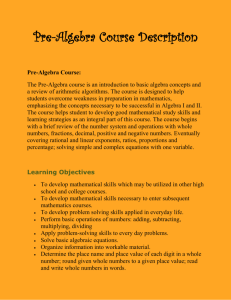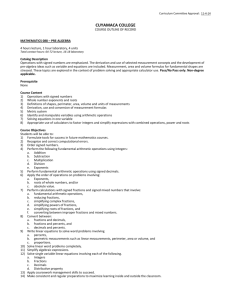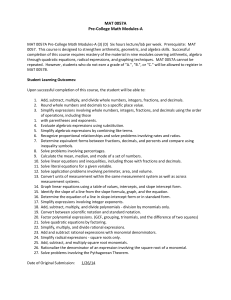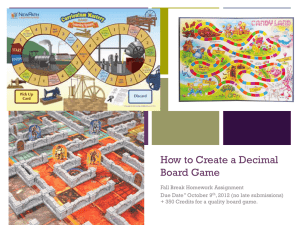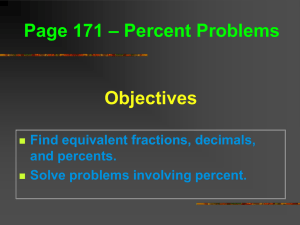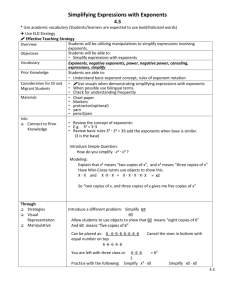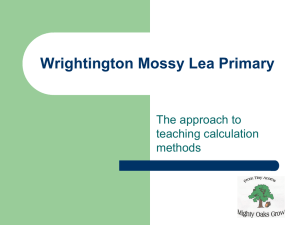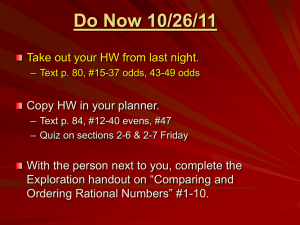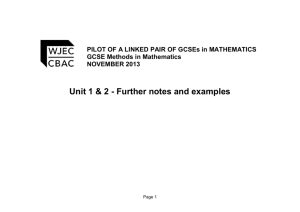MATD 0330 - Austin Community College
advertisement
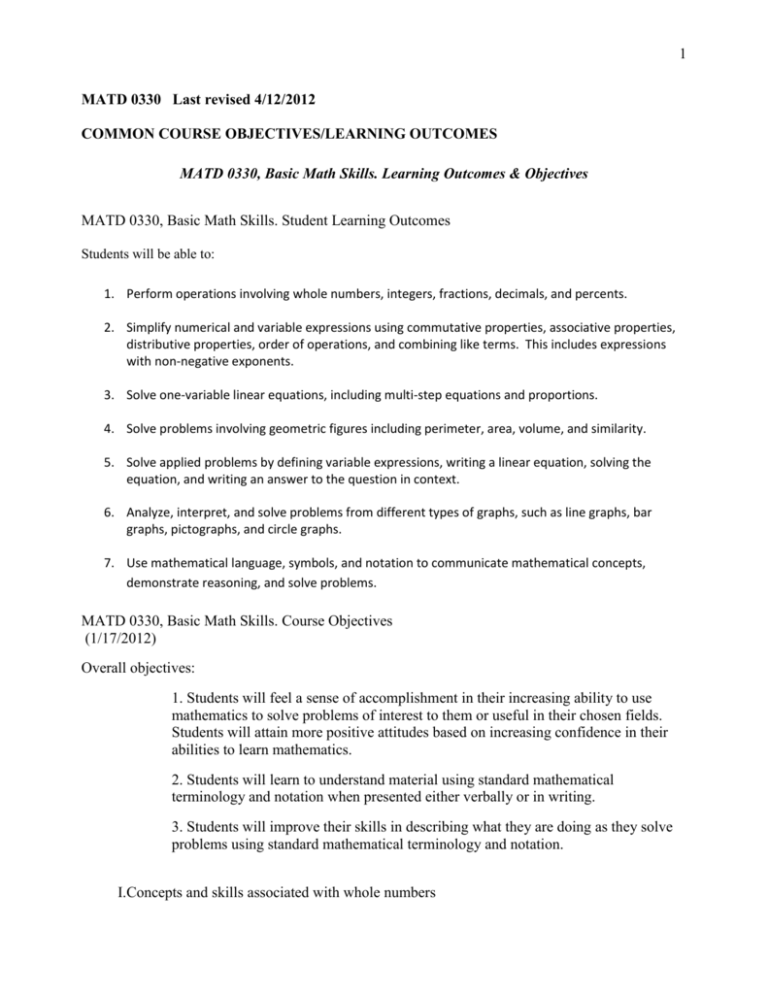
1 MATD 0330 Last revised 4/12/2012 COMMON COURSE OBJECTIVES/LEARNING OUTCOMES MATD 0330, Basic Math Skills. Learning Outcomes & Objectives MATD 0330, Basic Math Skills. Student Learning Outcomes Students will be able to: 1. Perform operations involving whole numbers, integers, fractions, decimals, and percents. 2. Simplify numerical and variable expressions using commutative properties, associative properties, distributive properties, order of operations, and combining like terms. This includes expressions with non-negative exponents. 3. Solve one-variable linear equations, including multi-step equations and proportions. 4. Solve problems involving geometric figures including perimeter, area, volume, and similarity. 5. Solve applied problems by defining variable expressions, writing a linear equation, solving the equation, and writing an answer to the question in context. 6. Analyze, interpret, and solve problems from different types of graphs, such as line graphs, bar graphs, pictographs, and circle graphs. 7. Use mathematical language, symbols, and notation to communicate mathematical concepts, demonstrate reasoning, and solve problems. MATD 0330, Basic Math Skills. Course Objectives (1/17/2012) Overall objectives: 1. Students will feel a sense of accomplishment in their increasing ability to use mathematics to solve problems of interest to them or useful in their chosen fields. Students will attain more positive attitudes based on increasing confidence in their abilities to learn mathematics. 2. Students will learn to understand material using standard mathematical terminology and notation when presented either verbally or in writing. 3. Students will improve their skills in describing what they are doing as they solve problems using standard mathematical terminology and notation. I.Concepts and skills associated with whole numbers 2 1.write the standard form of a whole number 2.round whole numbers and use rounding to estimate values involving whole number arithmetic 3.perform the four basic arithmetic operations (addition, subtraction, multiplication and division) on whole numbers 4.solve application problems involving the four basic operations on whole numbers 5.identify the order relation between two whole numbers 6.simplify exponential expressions with whole number exponents 7.use the order of operations to simplify expressions involving whole numbers, whole number exponents, grouping symbols, and the four basic arithmetic operations 8.prime factor whole numbers 9.find the least common multiple of two or more whole numbers II.Concepts and skills associated with fractions 1.perform the four basic arithmetic operations on fractions 2.solve application problems involving the four basic operations on fractions 3.simplify fractions to lowest terms 4.convert between mixed numbers and improper fractions 5.use the order of operations to simplify expressions involving fractions, whole number exponents, grouping symbols, and the four basic arithmetic operations 6.identify the order relation between two fractions III.Concepts and skills associated with decimals 1.write the standard form of a decimal 2.round decimals and use rounding to estimate values involving decimal arithmetic 3.perform the four basic arithmetic operations on decimals 4.solve application problems involving the four basic operations on decimals 5.convert between fractions and decimals 6.use the order of operations to simplify expressions involving decimals, whole number exponents, grouping symbols, and the four basic arithmetic operations 7.identify the order relation between two decimals or between a decimal and a fraction 3 IV.Concepts and skills associated with integers and rational numbers 1.perform the four basic arithmetic operations on rational numbers 2.use the order of operations to simplify expressions involving rational numbers, whole number exponents, grouping symbols, and the four basic arithmetic operations 3.solve application problems involving the four basic operations on rational numbers 4.identify the order relation between two rational numbers V.Concepts and skills associated with ratios, proportions and percents 1.convert between fractions and percents and between decimals and percents 2.solve percent equations 3.find the missing number in a proportion 4.solve ratio and proportion application problems 5.solve application problems involving percents VI.Concepts and skills involving linear equations in one variable 1.solve linear equations in one variable involving integers, decimals and fractions 2.solve application problems that yield linear equations VII.Concepts and skills associated with polynomials 1.identify terms of a polynomial, and classify polynomials by number of terms 2.use the exponent laws to simplify algebraic expressions involving whole number exponents 3.use the order of operations to evaluate variable expressions and formulas 4.combine like terms 5.add and subtract polynomials 6.multiply monomials by polynomials VIII.Use statistics to collect and interpret data 1.determine the mean, median, and mode 2.interpret graphs (pictographs, circle graphs, bar graphs and line graphs) and analyze data IX.Concepts and skills associated with geometry 4 1. know the appropriate vocabulary and facts about angles, triangles, rectangles, squares, and circles 2. find perimeters of rectilinear figures 3. use standard formulas to find perimeters and areas of triangles, rectangles, squares and circles 4. find complementary and supplementary angles 5. find angles associated with parallel lines cut by a transversal
